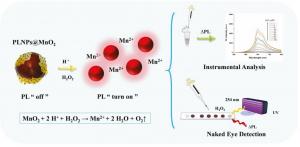Persistent luminescence nanoprobes bring rapid on-site H₂O₂ monitoring
GA, UNITED STATES, November 26, 2025 /EINPresswire.com/ -- Hydrogen peroxide (H₂O₂) plays essential roles in industrial processing, food production, and biological systems, but excessive residues pose health and safety concerns. Detecting H₂O₂ in real samples can be challenging due to interference from complex matrices and background fluorescence. This study introduces a persistent luminescence nanoparticle (PLNP)-based optical probe engineered to detect H₂O₂ with high sensitivity and without autofluorescence interference. The probe restores a bright red luminescence signal when exposed to H₂O₂, enabling both instrument-based quantitative detection and direct naked-eye visualization. Demonstrating high selectivity, reproducibility, and reliable performance in water, milk, and contact lens solution, this approach provides a versatile platform for rapid, sensitive, and on-site H₂O₂ monitoring.
Hydrogen peroxide (H₂O₂) is widely utilized as a disinfectant and oxidizing agent in food processing, pharmaceuticals, and consumer products. However, excessive residues can degrade nutrients and damage tissues, contributing to gastrointestinal irritation and potentially increasing cancer risk. Conventional detection methods—including electrochemical sensing, fluorescence probing, and enzyme-based assays—often require specialized equipment, continuous excitation, or complex sample preparation. Additionally, background autofluorescence in food or biological samples can significantly reduce signal clarity and accuracy. Based on these challenges, there is a growing need for a simple, sensitive, and autofluorescence-free method for detecting H₂O₂ in real sample conditions.
Researchers at Chengdu University and Hefei University of Technology have developed a new optical detection system for H₂O₂, using a persistent luminescence nanoprobe coated with a manganese dioxide (MnO₂) shell. The findings were published (DOI: 10.1093/fqsafe/fyaf040) on August 28, 2025, in Food Quality and Safety. The study demonstrates that the probe can detect H₂O₂ with high sensitivity in both solution-based measurements and simple naked-eye observations, offering a practical platform for on-site detection in resource-limited environments.
In this work, the researchers developed a persistent luminescence nanoprobe, PLNPs@MnO₂, in which near-infrared ZnGa₂O₄:Cr persistent luminescence nanoparticles were uniformly coated with a MnO₂ shell to create a switchable optical sensing system for H₂O₂ detection. In its initial state, the MnO₂ layer effectively quenched the luminescence emitted by the nanoparticle core through interfacial electron transfer, resulting in a “turned-off” signal. When H₂O₂ was present in a mildly acidic environment, MnO₂ was rapidly reduced to Mn²⁺, interrupting the quenching pathway and immediately restoring the persistent luminescence, thereby producing a clear, intensity-dependent signal. The detection limit reached 0.079 μmol/L, which is significantly more sensitive than many conventional fluorescence or electrochemical sensors that often suffer from background autofluorescence or matrix interference. Importantly, the restored red luminescence could also be visually recognized under UV illumination, allowing detection to be performed directly on flat plates or paper substrates without any instruments. The probe additionally demonstrated strong anti-interference performance in the presence of common ions, sugars, amino acids, and proteins, and exhibited excellent reproducibility and batch stability. Applications in bottled water, milk, and contact lens solutions yielded recovery rates ranging from 90.56% to 109.73%, confirming its reliability in real sample environments.
“The key innovation of this work lies in overcoming autofluorescence interference, which has long limited optical sensing in real-world food and biological matrices,” said the study’s corresponding author. “By using persistent luminescence instead of conventional fluorescence, our method produces clean, high-contrast signals without requiring continuous excitation. This makes the technology highly suitable for rapid, portable detection, even outside laboratory environments.”
This autofluorescence-free detection strategy offers practical advantages for food safety monitoring, environmental inspection, and biomedical assays. Its capability for naked-eye detection makes it particularly valuable in remote or resource-limited settings where laboratory instruments are unavailable. Future development may enable integration into smart packaging, wearable chemical sensors, and real-time contamination alert systems. By simplifying and accelerating H₂O₂ detection, this technology supports safer processing environments and improved consumer product quality assurance.
DOI
10.1093/fqsafe/fyaf040
Original Source URL
https://doi.org/10.1093/fqsafe/fyaf040
Funding information
This study was supported by the Natural Science Foundation of Sichuan Province (No. 2024NSFSC1266) and the Sichuan Innovation Team Project of National Modern Agricultural Industry Technology System (SCCXTD-2025-24), China.
Lucy Wang
BioDesign Research
email us here
Legal Disclaimer:
EIN Presswire provides this news content "as is" without warranty of any kind. We do not accept any responsibility or liability for the accuracy, content, images, videos, licenses, completeness, legality, or reliability of the information contained in this article. If you have any complaints or copyright issues related to this article, kindly contact the author above.

